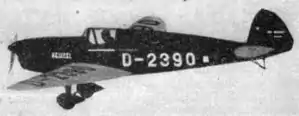| He 71 | |
|---|---|
 | |
| Role | Single-seat monoplane |
| National origin | Germany |
| Manufacturer | Heinkel |
| First flight | 1933 |
| Number built | 1 |
| Developed from | Heinkel He 64 |
The Heinkel He 71 was a German single-seat monoplane, a smaller version of the two-seat Heinkel He 64.[1] A low-wing monoplane with a fixed conventional landing gear, the prototype first flew with an open cockpit and a 60 hp (45 kW) Hirth HM 60 engine.[1] It was later modified with an enclosed cabin and a 78 hp (58 kW) Hirth HM 4 engine.[1] With additional fuel tanks to increase range it was used by German aviator Elly Beinhorn on a flight around Africa.[1]
Specifications (He 71B)

Heinkel He 71 B 3-view drawing from L'Aerophile May 1933
Data from [1]The Illustrated Encyclopedia of Aircraft
General characteristics
- Crew: 1
- Length: 6.97 m (22 ft 10 in)
- Wingspan: 9.50 m (31 ft 2 in)
- Height: 1.70 m (5 ft 7 in)
- Wing area: 12.90 m2 (138.9 sq ft)
- Empty weight: 310 kg (683 lb)
- Gross weight: 335 kg (739 lb)
- Max takeoff weight: 679 kg (1,497 lb)
- Powerplant: 1 × Hirth HM 4 , 58 kW (78 hp)
Performance
- Maximum speed: 200 km/h (120 mph, 110 kn)
- Cruise speed: 160 km/h (99 mph, 86 kn)
- Range: 2,410 km (1,500 mi, 1,300 nmi)
- Wing loading: 52.3 kg/m2 (10.7 lb/sq ft)
- Power/mass: 0.115
References
Wikimedia Commons has media related to Heinkel He 71.
- Notes
- Bibliography
- The Illustrated Encyclopedia of Aircraft (Part Work 1982-1985). Orbis Publishing.
This article is issued from Wikipedia. The text is licensed under Creative Commons - Attribution - Sharealike. Additional terms may apply for the media files.